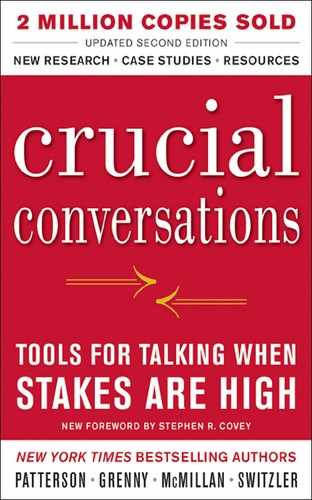MARIA’S NEW STORY
To see how this all fits together, let’s circle back to Maria. Let’s assume she’s retraced her Path to Action and separated the facts from the stories. Doing this has helped her realize that the story she told was incomplete, defensive, and hurtful. When she watched for the three clever stories, she saw them with painful clarity. Now she’s ready to tell the rest of the story. So she asks herself:
• Am I pretending not to notice my role in the problem?
“When I found out that Louis was holding project meetings without me, I felt like I should ask him about why I wasn’t included. I believed that if I did, I could open a dialogue that would help us work better together. But then I didn’t, and as my resentment grew, I was even less interested in broaching the subject.”
• Why would a reasonable, rational, and decent person do what Louis is doing?
“He really cares about producing good-quality work. Maybe he doesn’t realize that I’m as committed to the success of the project as he is.”
• What do I really want?
“I want a respectful relationship with Louis. And I want recognition for the work I do.”
• What would I do right now if I really wanted these results?
“I’d make an appointment to sit down with Louis and talk about how we work together.”
As we tell the rest of the story, we free ourselves from the poisoning effects of unhealthy emotions. Best of all, as we regain control and move back to dialogue, we become masters of our own emotions rather than hostages.
And what about Maria? What did she actually do? She scheduled a meeting with Louis. As she prepared for the meeting, she refused to feed her ugly and incomplete stories, admitted her own role in the problem, and entered the conversation with an open mind. Perhaps Louis wasn’t trying to make her appear bad or fill in for her incompetence.
As Maria sat down with Louis, she found a way to tentatively share what she had observed. (We’ll look at exactly how to do this in the next chapter.) Fortunately, not only did Maria master her story, but she knew how to talk about it as well. While engaging in healthy dialogue, Louis apologized for not including her in meetings with the boss. He explained that he was trying to give the boss a heads-up on some controversial parts of the presentation—and realized in retrospect that he shouldn’t have done this without her. He also apologized for dominating during the presentation. Maria learned from the conversation that Louis tends to talk more when he gets nervous. He suggested that they each be responsible for either the first or second half of the presentation and stick to their assignments so he would be less likely to crowd her out. The discussion ended with both of them understanding the other’s perspective and Louis promising to be more sensitive in the future.
